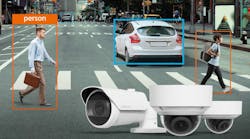A cutting-edge proposal to focus live video cameras on engineers at the controls of Metrolink trains is drawing fire from employee groups and skepticism from California's senior U.S. senator.
In response to the Chatsworth disaster in September, which occurred just after the commuter rail service's engineer illicitly sent and received cellphone text messages, Metrolink officials are forging ahead with plans to use on-board surveillance cameras to enforce safety rules.
"We're talking about the ability to look into a [locomotive] cab in real time and see what's happening," said Metrolink board member Richard Katz, who Los Angeles Mayor Antonio Villaraigosa placed on the panel after the deadly Sept. 12 crash.
Metrolink appears to be among the first commuter rail systems in the country moving to install the live cameras. They could be on trains in as little as six months, officials say, part of a series of efforts to reduce the chances of another Chatsworth-like catastrophe.
Twenty-five people died and 135 were injured when Ventura-bound Metrolink 111 ran a red light and slammed head-on into a freight train, according to federal investigators.
Railroad unions say the surveillance proposal will be costly, ineffective and an invasion of privacy.
"You've got Big Brother looking over your shoulder," said Tim Smith, state chairman of the Brotherhood of Locomotive Engineers and Trainmen, which represents Metrolink train operators.
Live video would be chiefly "punitive in nature," he said.
The priority should be installing technology "to stop the impending doom" of a collision when an engineer passes out or makes an egregious error, he said.
U.S. Sen. Dianne Feinstein (D-Calif.), who recently won approval of legislation requiring the installation of automatic train-stopping systems on Metrolink and other rail services by 2015, also is questioning the strategy.
"I find it hard to understand how adding cameras instead of extra engineers is a more effective way to increase passenger safety on Metrolink," she said.
"Candidly, I don't understand how an inanimate object like a camera protects against a crash. A camera can't speak out. It can't pull a lever. It can't stop the train. It can't take any action."
Live video recently was endorsed by a panel of safety experts after a two-month review of Metrolink operations.
Indeed, part of the thinking is that video cameras can eliminate the need for a second crew member in locomotives, a "second set of eyes" precaution that Metrolink officials added to several lines after the Chatsworth accident.
Some research has found that a second crew member can create distractions and actually contribute to accidents.
One important benefit of video and voice recordings is to understand and prevent accidents, said Mark V. Rosenker, acting chairman of the National Transportation Safety Board, which is leading a multi-agency inquiry into the Chatsworth collision.
For years, the NTSB has called for crash-proof voice recorders on trains, although Metrolink and many other rail lines don't have them.
Now, the agency is urging federal rail regulators to consider making it mandatory for rail lines to install hardened recorders that can capture video and sounds.
"I think video in the cab clearly would have been a valuable tool" in the Chatsworth probe, Rosenker said. "A whole host of information . . . would have been on the tape. It would have been a factual [record] of what the engineer was doing and not doing."
On-board recordings must be used only for accident investigations and protected from public release by federal law, he said.
How video, particularly live feeds, would be controlled and used under the Metrolink proposal is a major worry, said Frank Wilner, a national spokesman for the United Transportation Union, which represents some Metrolink rail workers.
Employees fear the images could be arbitrarily used by supervisors to rack up minor rule infractions, he said.
"Crews are legitimately concerned about their livelihood," he said. Live video is not welcomed "any more than you would want a camera trained on you while you were doing your job."
Even commercial airliners don't have video in cockpits, Wilner and others note. Pilots have strongly resisted cameras.
"It's not just a privacy issue," said pilot Rory Kay, executive safety chairman for the Air Line Pilots Assn. "We've always felt there is tremendous subjectivity to visual information."
Experience shows that video images can be interpreted differently by different viewers, he said.
Much more reliable, he said, are computer records that capture thousands of pieces of information on an airplane's operations.
Some video proponents note that Metropolitan Transportation Authority trains and buses already have cameras.
But on those subway and light-rail trains, cameras are pointed at the tracks ahead and behind the cars.
On buses, the video records of drivers are kept in secure, on-board recorders. That information is used only after the fact to investigate accidents and attacks on drivers, not to enforce safety rules, an MTA spokesman said.
Proposals to install video cameras aimed at the track ahead of Metrolink trains were being considered before the Chatsworth crash, said Metrolink spokesman Francisco Oaxaca.
How the more ambitious plan for live video of crews would work and how the recordings would be reviewed remains to be seen.
Planners hope to resolve issues cooperatively with employee unions and the company that supplies Metrolink train crews, Connex Railroad, a subsidiary of Veolia Transportation, Oaxaca said.
"We do not want to move forward without completely addressing any concerns they may have," he said.
Still, key Metrolink board members say they want live video cameras soon. They say it is the most effective way to enforce critical safety rules in the field, including the ban on use of personal electronic devices.
Live video would ensure "no slacking off," said Metrolink board member Keith Millhouse, and foster a "safety culture in [train crews], knowing that they have to operate at 110% efficiency at all times."


